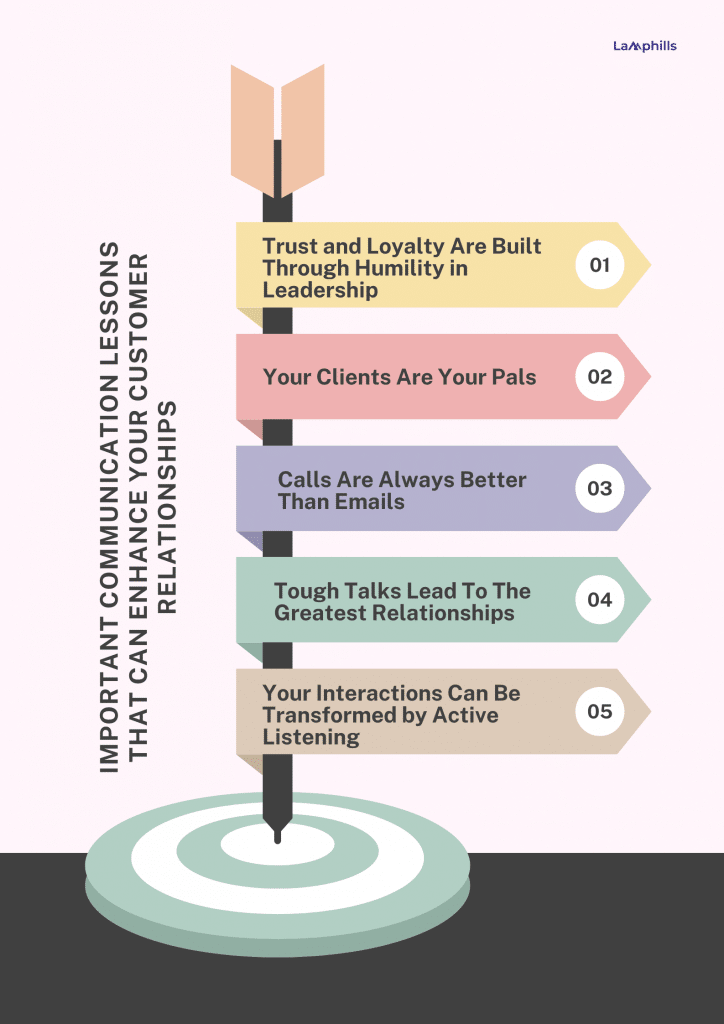Struggling to Truly Connect with Customers? Join the Club.
I know how tough effective customer communication is first-hand. Getting attention is brutally hard these days. Inboxes overflow with generic emails. But brands mastering customer communication have a huge advantage. Better communication increases sales, loyalty, and satisfaction. It reduces frustration, churn, and complaints.
That’s why in 2024, top brands use innovative strategies and tools. They go beyond boring emails. They nurture real connections through personalized messaging, video, chat, and more.
This guide explores cutting-edge customer communication for 2024. You’ll discover strategies from customer experience leaders. You’ll learn engagement tactics for every buyer journey stage.
Key Points:
- The toughest customer conversations often present the greatest opportunities to strengthen relationships by listening and finding solutions.
- A Facebook Live Q&A session is an excellent technique to engage your customers in a conversation that makes them feel heard
- Active listening is crucial for effective customer communication. So, try to truly understand the customer’s perspective and needs.
- The most excellent way to demonstrate to your consumers that you care is to establish a system exclusively dedicated to customer service
What is Customer Service Communication?
Effective customer communication is the cornerstone of any successful business relationship. It entails actively listening to your customers, comprehending their messages, and taking steps to improve their experience with your product or service.
Read: Brand Resonance: Elevating Brand Resonance Through Experiential Engagement
I’ve had conversations in which responses were implied rather than stated directly. This also happens to clients. A skilled customer care representative must read between the lines and grasp what isn’t expressed. Then, they can use the information clients withhold to devise new ways of assisting.
Why is Customer Communication Important?
Customer communication is essential because firms with a good reputation benefit from repeat sales and word-of-mouth advertising. How your staff communicates with consumers can make them feel valued and leave a great impression on their experience. Alternatively, it can make them feel ignored and disgruntled, ensuring they will take their future business elsewhere (and most likely spread the word about their unpleasant feelings).
When considering customer communication, remember that consumer-brand interactions are analogous to those between friends. A friend once told me that if you tell your friend their recent behavior has disappointed you and they answer abruptly and indifferently; your friendship will suffer. However, if your friend listens to you, addresses the issue, and adjusts their conduct in the future, you will likely appreciate them even more.
The same goes for brands and how they interact with customers. Everything counts, from the tone of voice used on a customer service contact to the uniformity of marketing messages across platforms. Customers should feel they are getting to know a brand and that the company appreciates them. All relationships are essential.
Important Communication Lessons That Can Enhance Your Customer Relationships
Every organization has a unique approach to customer communication, whether adhering to the “the customer is always right” rule or using a pre-written script meant to defuse tense situations. Each customer service team uses its prior experiences to communicate with customers in the most efficient manner possible. Still, since this process changes over time, the methods you employ today might not be the ones you used when you first started.

So let’s look at some lessons that can enhance your customer’s relationship:
#1. Trust and Loyalty Are Built Through Humility in Leadership
Be a humble leader. Own up to your mistakes and show your clients you are accountable. I’ve encountered possible conflict numerous times, but it was always handled by choosing the easiest route—removing the justifications. Consumers don’t care about the reasoning behind your or your company’s mistakes; they just want to be heard.
You’d be shocked at the respect your clients will accord you when you say, “This is entirely my fault and has nothing to do with my team.” Here’s what I’m doing to make things right and I apologize.” After that, carry out your promised actions.
#2. Your Clients Are Your Pals
Your clients are your allies. You must adopt the mindset that conversing with your clients is the same as conversing with your friends. Since every connection, whether professional or personal, is a two-way street, you want your clients to feel as though they are getting to know you and that you appreciate and value them. In this kind of communication, tone is essential.
When communicating with your customers, it’s crucial to maintain a consistent tone throughout—from customer service conversations to marketing communications distributed on various channels. All members of your team must be conversant in communicating with clients, be it via a sales call or a grievance. Customer happiness results from how you interact with them and attend to their demands.
#3. Calls Are Always Better Than Emails
One of the biggest lessons I have learned is that phone calls are always preferable to emails regarding client contact. Ensure all the information is understood by calling your consumer, especially when discussing difficult or complex subjects. Emails are prone to misinterpretation, and without immediate reaction, problems may worsen without your knowledge.
#4. Tough Talks Lead To The Greatest Relationships
Although having talks with satisfied customers is terrific, the best relationships are developed during challenging conversations. There are chances to improve those relationships when you take the time to listen to your clients and understand their viewpoints genuinely. These days, I embrace the chance to speak with clients and push my team members to request and accept input.
#5. Your Interactions Can Be Transformed by Active Listening
The most important thing I’ve learned is how powerful active listening is. I’ve developed trust, adapted solutions to specific needs, and proactively resolved disputes by sincerely attempting to understand my clients. My organization’s customer success operations have changed due to this insight. We have created robust feedback systems, engaged in communication training for my team, and incorporated a customer-centric approach into decision-making. Active listening transforms every conversation into a worthwhile opportunity, making it more than a skill. It’s the foundation of my company’s long-term success.
Effective Ways to Communicate With Customers
Modern business communications give you more ways to find and retain customers.
Not so long ago, if you wanted to contact your clients directly, there were only three methods to go about it: by phone, by mail, or face-to-face. However, the emergence of new technology has drastically broadened commercial communications. You can now communicate with your customers—and vice versa—via various channels. While some may appear basic, each plays a crucial role in a company’s communication strategy. Here are the best ways I communicate with my clients and you should too.
#1. Phone Technology
Modern phone technology enables you to employ automated menus to respond to consumer questions and/or direct them to the appropriate person in your business. While some clients grumble about such technology, it might help you reach the most people in the shortest amount of time. New callback technology can help keep your consumers from waiting on hold. Call them back when a representative is available instead of making them listen to elevator music. This reduces hang-ups and improves your ability to communicate with any consumer who reaches you.
#2. Social Media
Social media has introduced a completely new manner of interacting with clients. On one level, you can utilize your accounts to market your products and brand. You can, however, utilize your accounts to communicate with others one-on-one. Customers can contact your representatives directly through Facebook. You can utilize dedicated service hashtags on Twitter to allow customers to tweet their issues and receive immediate responses. If you want to go further, you can track every mention of your company, identify those with complaints or queries, and then respond with an offer to help. Social media allows you to respond more quickly than ever before.
#3. Web Chat
Not every consumer wants to call and ask a question. That is why incorporating a chat feature onto your website might be beneficial. To initiate a conversation via web chat, a consumer just types in a query. Web chat apps enable you to automate responses to basic questions while bringing in a representative for more difficult ones. It makes it easier for clients to find you and for you to assist them.
#4. E-mail
E-mail may appear outdated, but it remains one of the finest ways to communicate with customers because it is convenient, inexpensive, and quick. If you have a new product or service, you can utilize email to send newsletters and/or tailored messaging. In addition, your consumers can utilize email to contact you about everything from complaints to new orders. It is a crucial part of every company’s communication platform.
#5. Text message
Text messaging is also a great way to connect with customers, regardless of size. For smaller businesses, it’s a convenient way to communicate about meetings, orders, and delivery schedules quickly. Customers can opt-in for text messaging about offers and deals for larger businesses. You can also have a dedicated texting support number that allows customers to text instead of calling.
#6. Video messaging
Consider it a modern way to hold a face-to-face meeting. Video chat solutions like Skype enable you to engage with a customer via video, which can help you create relationships and streamline certain transactions.
#7. Handwritten Notes
Technology has transformed our lives and business communications. However, a personal touch can still be quite effective. Sending a handwritten note in the mail now and then is one of the most effective ways to connect with your customers personally. Even a simple thank-you card might help you strengthen professional relationships.
#8. Website
Creating a website is essential for any organization. Customers rely on websites for information and, in many circumstances, expect to be able to order things and track order fulfillment timetables. If you don’t have a website, you’re missing out on one of the most effective methods to communicate with clients.
Checklist on Customer Communication.pdf
How To Improve Communication With Your Customers
Sometimes brands must mend their relationships. This could be the result of long-standing communication challenges with clients. Fortunately, even organizations that haven’t always excelled at consumer interaction can enhance their connection with their target demographic.
Let’s check out the list of how to improve communication with your customers:
#1. Establish a Two-Way Communication Channel
Use social media tools to foster communication between you and your consumers. For example, on Twitter, ensure customers can tweet their problems to you and get a response in the same thread. Facebook Messenger provides a personalized platform for discussing questions or concerns. A Facebook Live Q&A session is another excellent technique to engage your customers in a conversation that makes them feel heard.
This communication approach also generates valuable data sets that will help you reach consumers in the future.
#2. Respond to dissatisfied Customers
While it may be tempting to disregard disrespectful remarks or negative reviews, doing so will only ruin your reputation. Do not avoid the situation; address it with genuine concern and an open mind.
“Consumers are people and want to be treated as such. Answer their queries and address their problems as if you were attempting to help your mother. “Be personable and genuinely interested in their concerns.”
According to a recent study on customer experience trends, 72% of customers are willing to forgive a company’s error if they receive exceptional customer service to remedy the issue. This indicates that maintaining clients is worth a few minutes of your time.
#3. Respond Promptly
Sometimes responding to criticisms and concerns isn’t enough. Do your utmost to answer within 24 hours to show the customer that their complaints are essential to you. The most excellent way to demonstrate to your consumers that you care is to establish a system exclusively dedicated to customer service.
“If you’re taking a proactive approach, you’re already halfway there, The key to staying on top of customer reviews is to actively seek them out and prepare a strategy and approach ahead of time. As with many critical company processes, preparation and planning go a long way.”
Outsourcing customer care to a leading call center or a virtual answering service is one approach to ensure that client problems.
#4. Resolve Concerns Online
To promote open communication on internet platforms, treat public issues and evaluations like private emails and phone conversations. One poor comment might go viral, spreading the impression that your company is unprofessional.
You want to be sure that your brand is responding from a place of empathy as well as showing the brand’s ability to admit fault by issuing an apology when appropriate. Nobody is perfect, including some of the world’s most successful businesses. If you make a mistake, it’s okay. Accept responsibility and propose a solution.
What Do You Mean By Customer Communication?
Customer communications are exchanges over various media, including digital and physical touchpoints, between businesses and their clients. Customer communication can occur in person, over the phone, over text, or through chat.
What Is Essential In Customer Communication?
Just like any other ability, active listening requires practice. Participate actively in the discussion and don’t hesitate to ask clarifying questions if you’re unsure about something. Rephrasing what your consumers say to you and having them repeat it to you can also assist in making things clearer.
What Are The Types of Customer Communications?
Face-to-face communication between a customer and a customer service agent constitutes in-person support.
- Phone assistance.
- Send an email to support.
- Support for SMS, social media, etc.
- Live help via web chat.
- Customer service via video.
- Support and documentation for self-service.
What Are The Benefits of Good Communication With Customers?
- Client contentment
- Increasing output and sales
- Improved connections with customers
- Enhances brand credibility Feedback
- <ore fidelity to the brand
- Promoting creativity improves company culture
Conclusion
As you can see, enhancing customer communications requires careful consideration of numerous elements. Following these best practices and iterating to enhance your customer communication techniques over time, you can gain your consumers’ trust and loyalty.
Related Articles
- Is Communications a Good Major? All You Need to Know
- What Does Integrated Communications Marketing Do For Your Business: All You Need To Know
- Corporate Communications: Strategies to Amplify Your Brand’s Message
- CRISIS COMMUNICATION: Definition and Best Strategies
- MEDIUMS OF COMMUNICATION: Types and Examples






